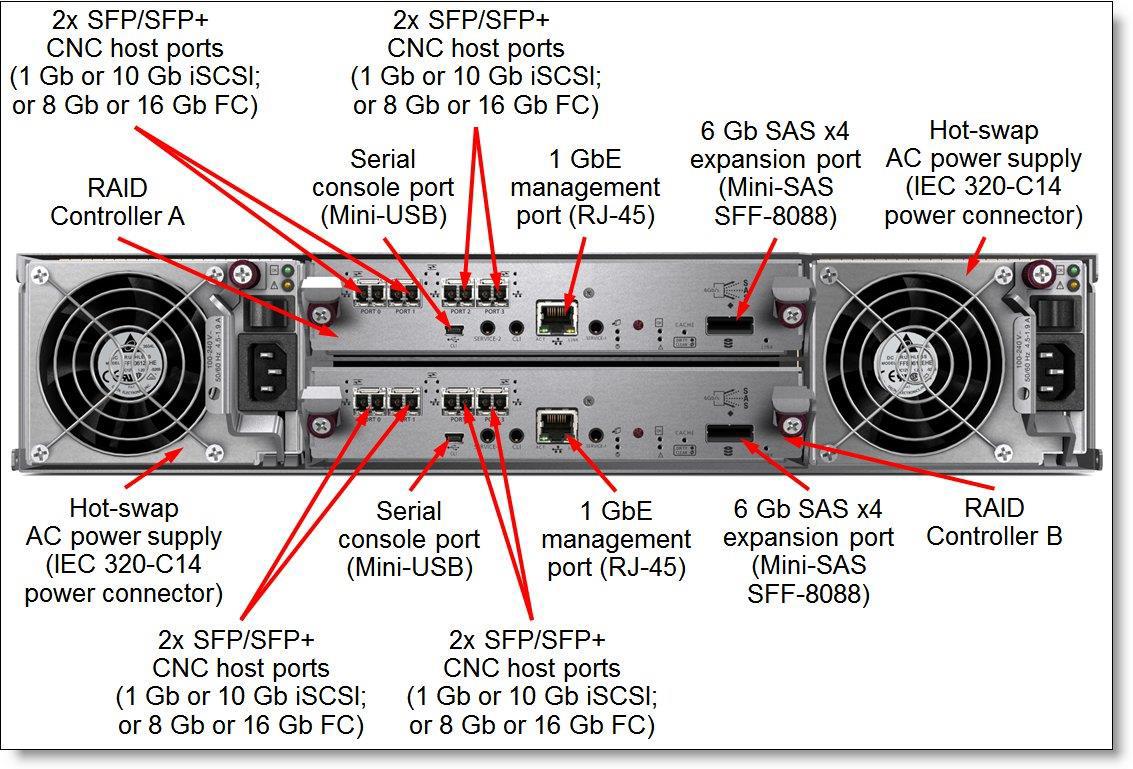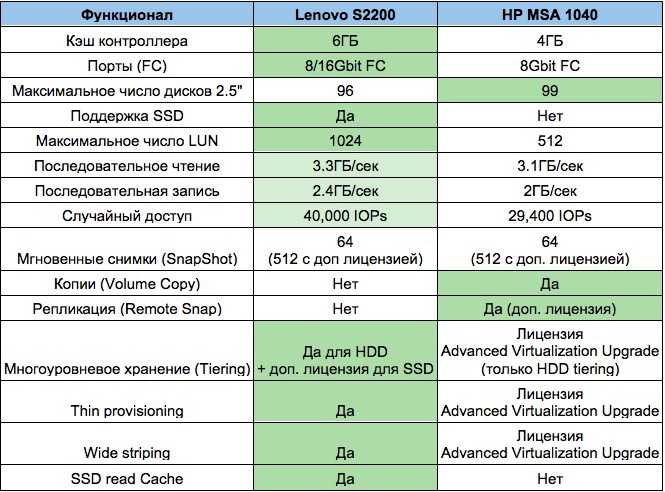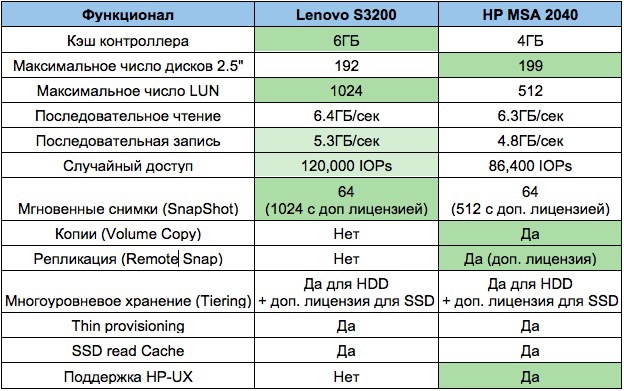Who is stronger - an elephant or ... an elephant?
Lenovo recently introduced two new S2200 and S3200 disk systems. They are designed primarily for small business. The competition in this market is quite active - among the most active HP players with MSA systems, Dell with MD3, NetApp E2700 and FAS2500, EMC VNXe, IBM V3700 and a number of B-brands.

If you look at the characteristics of the announced new products, we will see the classical architecture of the dual-controller array, which is scaled vertically (by adding disk shelves). For the S2200, the maximum number of disks is 96 (controller module and 3 shelves with 24 disks each), for the S3200 a maximum of 192 disks can be connected (controller module and 7 shelves with 24 disks each). If you use the shelves with 3.5 "disks (12 disks per shelf), then the maximum number of disks will be 48 and 96, respectively.
The main differences between the models presented are the maximum system capacity, the number of host ports and the performance:

')
For the S2200 system, there is also a choice of two options: either two SAS 12 Gbit ports per controller, or 2 convergent ports (1 Gbit / 10 Gbit iSCSI or 8 Gbit / 16 Gbit FC). There is no longer possible to get a multiprotocol system - the choice must be made at the launch stage - since the type of ports is selected immediately for a pair, the system will support either iSCSI or FC.
Interestingly, FCoE technology is not supported, although, due to the fact that over the past few years its popularity has not grown much, it is unlikely that this will become a serious problem for customers. But for iSCSI, both copper and optical interfaces are supported.

Expansion shelves connect through SAS 6Gbps ports (12Gbps ports are used only for hosts).
The amount of cache memory in S2200 and S3200 systems is 6GB (per controller), cache protection in case of power failures is ensured by resetting data to flash at the expense of supercapacitors.
Of the interesting features of the systems it is worth mentioning:
• Multi-level storage. The standard package only works between different types of hard drives (Intelligent Real-time Tiering for HDDs). You can store master data on slow NL SAS disks, and “hot” data will automatically be transferred to fast SAS disks. Additional license allows organizing multi-level storage on SSD (Intelligent Real-time Tiering for SSDs).
• Caching on SSD (SSD Read Cache). If the load on the system is mainly created by read operations, then using this function will expand the controller's cache and provide faster access to the most requested data.
• Through the use of wide-striping (data is distributed across all disk groups), higher performance is achieved and discs are evenly loaded.
• Fast rebuild (Rapid RAID Rebuild) due to the restoration of only those stripes that were damaged.
The controllers in the S3200 system are of two types - with a SAS 12Gbit interface for hosts (4 ports per controller) and converged FC / iSCSI interfaces (4 ports per controller). For converged ports, the user can choose the interface type for each group of two ports: 1Gbps / 10Gbps iSCSI or 8Gbps / 16Gbps FC, thus, you can get a variety of storage configurations without buying additional interface modules. Of course, if the modules could be changed, then the flexibility would be even greater (you cannot get the configuration of FC / SAS or iSCSI / SAS).
The attentive reader, who is familiar with the entry-level storage market, must have seen familiar characteristics. Yes exactly! Lenovo S2200 and S3200 as two drops of water are similar to HP MSA 1040 and MSA 2040 storage systems that have already gained popularity. And this is not surprising, since the “parent” of all these systems is DotHill AssuredSAN 3004/4004.
Surprisingly, Lenovo didn’t take the most up-to-date models as the basis for its product line of storage systems, but this is probably due to the fact that the target audience still has enough of a large supply for the coming years.
Of course, the models from HP and Lenovo are not exactly the same - there are some differences that will help make a choice in favor of this or that system. Below we have collected the differences in the tables:


As for performance data, it is too early to draw definitive conclusions - there may be many reasons for such discrepancies. We have not yet seen the “inside” controller from Lenovo, it is quite possible that it uses a slightly faster processor. For the S2200 / MAS 1040, the case may be in supporting 16Gbit FC, since the latency for 16Gbit is lower, you can get higher test results. And, of course, there are no test details: HP publishes configuration data on disks, and Lenovo could take peak values to work with the cache. So, I’d definitely not recommend relying entirely on performance data when choosing between two systems.
As you can see, in many ways the systems are close and the differences for many customers will not be significant. Therefore, if we discard preferences between brands, the choice will depend on the need for support for replication between systems and on the price of the solution. If there is no need for replication, then the S2200 looks like a more interesting option than MSA 1040. In the case of the S3200 and MSA 2040, it is difficult to make a definite conclusion — preference is already coming into force and, of course, the price issue.
With confidence, however, it can be argued that in the wake of the sanctions, the offer from Lenovo will be very interesting for a number of customers and will not be ignored.
References:
lenovopress.com/tips1298
lenovopress.com/tips1299
shop.lenovo.com/us/en/systems/storage/san/lenovo-storage
www.dothill.com/storage-arrays/assuredsan-4000-san-storage
More interesting articles on the Trinity blog

If you look at the characteristics of the announced new products, we will see the classical architecture of the dual-controller array, which is scaled vertically (by adding disk shelves). For the S2200, the maximum number of disks is 96 (controller module and 3 shelves with 24 disks each), for the S3200 a maximum of 192 disks can be connected (controller module and 7 shelves with 24 disks each). If you use the shelves with 3.5 "disks (12 disks per shelf), then the maximum number of disks will be 48 and 96, respectively.
The main differences between the models presented are the maximum system capacity, the number of host ports and the performance:

')
For the S2200 system, there is also a choice of two options: either two SAS 12 Gbit ports per controller, or 2 convergent ports (1 Gbit / 10 Gbit iSCSI or 8 Gbit / 16 Gbit FC). There is no longer possible to get a multiprotocol system - the choice must be made at the launch stage - since the type of ports is selected immediately for a pair, the system will support either iSCSI or FC.
Interestingly, FCoE technology is not supported, although, due to the fact that over the past few years its popularity has not grown much, it is unlikely that this will become a serious problem for customers. But for iSCSI, both copper and optical interfaces are supported.

Expansion shelves connect through SAS 6Gbps ports (12Gbps ports are used only for hosts).
The amount of cache memory in S2200 and S3200 systems is 6GB (per controller), cache protection in case of power failures is ensured by resetting data to flash at the expense of supercapacitors.
Of the interesting features of the systems it is worth mentioning:
• Multi-level storage. The standard package only works between different types of hard drives (Intelligent Real-time Tiering for HDDs). You can store master data on slow NL SAS disks, and “hot” data will automatically be transferred to fast SAS disks. Additional license allows organizing multi-level storage on SSD (Intelligent Real-time Tiering for SSDs).
• Caching on SSD (SSD Read Cache). If the load on the system is mainly created by read operations, then using this function will expand the controller's cache and provide faster access to the most requested data.
• Through the use of wide-striping (data is distributed across all disk groups), higher performance is achieved and discs are evenly loaded.
• Fast rebuild (Rapid RAID Rebuild) due to the restoration of only those stripes that were damaged.
The controllers in the S3200 system are of two types - with a SAS 12Gbit interface for hosts (4 ports per controller) and converged FC / iSCSI interfaces (4 ports per controller). For converged ports, the user can choose the interface type for each group of two ports: 1Gbps / 10Gbps iSCSI or 8Gbps / 16Gbps FC, thus, you can get a variety of storage configurations without buying additional interface modules. Of course, if the modules could be changed, then the flexibility would be even greater (you cannot get the configuration of FC / SAS or iSCSI / SAS).
The attentive reader, who is familiar with the entry-level storage market, must have seen familiar characteristics. Yes exactly! Lenovo S2200 and S3200 as two drops of water are similar to HP MSA 1040 and MSA 2040 storage systems that have already gained popularity. And this is not surprising, since the “parent” of all these systems is DotHill AssuredSAN 3004/4004.
Surprisingly, Lenovo didn’t take the most up-to-date models as the basis for its product line of storage systems, but this is probably due to the fact that the target audience still has enough of a large supply for the coming years.
Of course, the models from HP and Lenovo are not exactly the same - there are some differences that will help make a choice in favor of this or that system. Below we have collected the differences in the tables:


As for performance data, it is too early to draw definitive conclusions - there may be many reasons for such discrepancies. We have not yet seen the “inside” controller from Lenovo, it is quite possible that it uses a slightly faster processor. For the S2200 / MAS 1040, the case may be in supporting 16Gbit FC, since the latency for 16Gbit is lower, you can get higher test results. And, of course, there are no test details: HP publishes configuration data on disks, and Lenovo could take peak values to work with the cache. So, I’d definitely not recommend relying entirely on performance data when choosing between two systems.
As you can see, in many ways the systems are close and the differences for many customers will not be significant. Therefore, if we discard preferences between brands, the choice will depend on the need for support for replication between systems and on the price of the solution. If there is no need for replication, then the S2200 looks like a more interesting option than MSA 1040. In the case of the S3200 and MSA 2040, it is difficult to make a definite conclusion — preference is already coming into force and, of course, the price issue.
With confidence, however, it can be argued that in the wake of the sanctions, the offer from Lenovo will be very interesting for a number of customers and will not be ignored.
References:
lenovopress.com/tips1298
lenovopress.com/tips1299
shop.lenovo.com/us/en/systems/storage/san/lenovo-storage
www.dothill.com/storage-arrays/assuredsan-4000-san-storage
More interesting articles on the Trinity blog
Source: https://habr.com/ru/post/260957/
All Articles